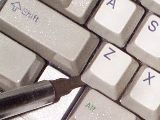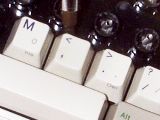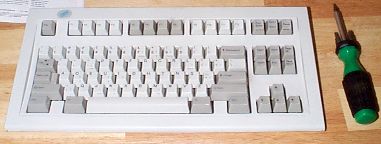Convert Your Model M to a "Post-Ban" Dvorak
Reported 1999-07-06 11:55 by V-Groove Fusion Splicer
In celebration of The United States' 223rd birthday, Pigdog Journal is proud to bring to you special care and handling instructions for that essential tool of liberty, the Model M keyboard.
The IBM Model M keyboard (P/N 1391401) is perhaps the finest, best-made typing device in production. Its sturdy construction, positive-response key action, and ease of maintenance are legendary. Due to the laws and regulations in many jurisdictions, and the efforts of powerful lobbyists who stand to gain tremendous personal profit and gain from the creation of an ergonomics-industrial complex growing wealthy and fat off of our pain, the Model M is manufactured exclusively in the QWERTY configuration.
The Dvorak 'simplified' keyboard layout was developed in the 1920's and 30s by August Dvorak and William Dealey. It promises smoother, faster, more efficient typing in the hands of a professional. Thanks to the powerful anti-Dvorak lobby, a keyboard laid out in the Dvorak manner is nearly impossible to come by in this country, despite the efforts of First Amendment advocates to keep them free and accessable to the common man, as our founding fathers intended.
Fortunately for free expression, the intelligent design of the IBM Model M keyboard makes it possible to convert, or retrofit, a QWERTY Model M to a fully-functional Dvorak. I undertook such an endeavor this Fourth of July.
 |
The 'Z' key is a good |
The key to the procedure (no pun intended) is the Model M's removable key caps. Many Model M enthusiasts are aware that the key caps are removable and in fact machine-washable. Most haven't considered the possibility of rearranging the keys. Not only is it possible to rearrange the Model M's keys, it's actually quite simple.
It's worth mentioning that many manufacturers of keyboards thwart a Dvorak retrofit in one of two ways. First, by constructing their keyboards in such a way that the keys cannot be removed, or so that removal of the keys requires special tools and might damage the keyboard if done by someone without the proper training. Second, many manufacturers create non-interchangeable keys by altering the size of the key or the angle of its face based on the row in which the key sits. Either of these makes use of the keyboard inconsistant and uncomfortable, ultimately degrading both speed and accuracy. The Model M, to IBM's credit, has none of these handicaps.
Note that the pictures illustrating this article do not use a standard Model M (P/N 1391401) but rather my personal keyboard of choice, the Model M Spacesaver (P/N 1397881). I prefer the Spacesaver for its compact size, which helps to minimize hand travel. The Spacesaver sports the same fine construction and workmanship as the regular Model M. For the purposes of these instructions, the keyboards can be considered identical.
 |
Don't remove the 'A' |
 |
...also leave the 'M' |
Begin by removing the alphabet keys and the punctuation keys. Do this by gently prying the keys off one by one. A good place to start is the 'Z' key. Since the 'Z' is adjacent to the part of the case between the 'Ctrl' and 'Alt' keys on the left side of the board, you'll have a solid surface to use as a fulcrum without having to remove the space bar or any other keys unneccesarily. When removing keys, leave both the 'A' and the 'M' keys. Neither changes position from QWERTY to Dvorak.
In addition to the alphabet keys, remove the following punctuation keys which will change position in the conversion:
| _ | + | { | } | : | " | < | > | ? | ||||||||
| - | = | [ | ] | ; | ' | , | . | / |
Once the selected alphabet and punctuation keys have been removed, it's time to put the keys back onto the keyboard in the Dvorak configuration. You may wish to take this opportunity to clear away any 'cruft,' or debris that has collected inside the keyboard. It's also an excellent time to clean the keys themselves!
| ~ | ! | @ | # | $ | % | ^ | & | * | ( | ) | { | } | BS | |||||||||||||
| ` | 1 | 2 | 3 | 4 | 5 | 6 | 7 | 8 | 9 | 0 | [ | ] | ||||||||||||||
| TAB | " | < | > | P | Y | F | G | C | R | L | ? | + | | | |||||||||||||
| ' | , | . | / | = | \ | |||||||||||||||||||||
| Caps Lock | A | O | E | U | I | D | H | T | N | S | _ | Enter | ||||||||||||
| - | ||||||||||||||||||||||||
| Shift | : | Q | J | K | X | B | M | W | V | Z | Shift | |||||||||||
| ; | ||||||||||||||||||||||
| Ctrl | Alt | Ctrl | Alt | ||||||
| |||||||||
The keycaps are replaced in a manner much like the way they were removed. Position the keycap over the spring housing corresponding to the position of the character on the keycap and place it down over the housing. Place one finger on the keycap and push as though you were trying to loosen a stuck key. You want to apply firm pressure, but if you feel you are forcing the key down, stop. You may have aligned the key improperly. The keys should snap into place easily.
 |
|  |
|  |
|  |
|  |
Replace the keycaps by placing over the spring housing and pushing down firmly | ||||||||
Once the keys are in place, you'll have finished your conversion. There are a few minor issues that should be brought up at this point.
The keyboard layout provided above is a "common" version of the Dvorak layout and does not conform to the ANSI Dvorak layout specification. ANSI Dvorak for example requires the "[" and "]" to be on the same key, so that the shift key must be pressed to get at the closing bracket. this would require the manufacture of special keys, and so the layout shown in this article has come into much more widespread use. The key layout shown here matches the layout referred to as "Dvorak" by Microsoft and Apple in their configuration utilities.
The "F" and "J" keys are now nowhere near the home key position, and the new home keys, "U" and "H," have no "pips" so that you can more easily find your hand position without having to look down at the keyboard. This can be disconcerting to a touch-typist, and why would you want a Dvorak keyboard if you weren't at least planning on training to touch-type? I don't have a perfect solution to this problem. Possible solutions include using a miniscule amount of epoxy resin or silicone adhesive to create new keyboard pips. If there's a reseller for spare Model M key caps, I'd sure like to know if Dvorak alternate keys are available. I don't believe it would be worth the effort to file down the "J" and "F" keys.
 |
A fully-converted Dvorak Model M Spacesaver |
Of course, neither of these should impede your increased speed and accuracy with your newly-converted Dvorak Model M. With proper training and drills, you'll be exceeding your old typing speeds within a month.
A final note: except for a few older models 'grandfathered' into recent legislation, possession of the Dvorak 'simplified' keyboard can get you jail time in many states and European countries. Therefore, unless you happen to live in a place that values freedom and the right to free speech, this article is provided for informational purposes only, and is not intended to promote the use or collection of actual Dvorak keyboards. Specifically, Pigdog Journal does not endorse any efforts to commit crimes using Dvorak keyboards, nor do we wish to encourage the stockpiling of Dvorak keyboards or burying cases full of them in your backyards, nor do we endorse furnishing your underground bunker with Dvorak Model M keyboards for when the revolution comes. Those things would be bad. Don't do them.
Remember to always type safely.
T O P S T O R I E S
California Glory Hole attracts huge crowds
A glory hole at Napa's Lake Berryessa is drawing huge crowds. According to Chris Lee, the general manager for the Solano County Water Agency, the glory hole hasn't been active since 2019, and only restarted operations on Feb 4. (More...)
Republican State Senator busted after soliciting a teenage girl
Republican State Senator Justin Eichorn of Minnesota was arrested for soliciting a teen girl on Monday just hours after he introduced a bill proposing "Trump derangement syndrome" (TDS) as a form of mental illness. (More...)
Parents claim measles is not that bad after having only one child die
The parents of a Texas girl who died from the measles are defending their decision not to vaccinate their daughter. "She says they would still say 'Don't do the shots,'" an unidentified translator for the parents said. "They think it’s not as bad as the media is making it out to be." (More...)
Delusional rich man tries to fire town staff
"I'm mayor now" said write-in mayoral candidate and founder of Pirate’s Booty Snacks Robert Ehrlich after losing the election for Mayor of Sea Cliff, NY. Then he tried to take over the Village Hall and fire everyone. (More...)
Musk claims Xitter security is staffed by idiots
Earlier this month Xitter experienced a massive outage. In an interview, Musk told Fox Business that he believes the attack came from "IP addresses originating in the Ukraine area." (More...)
The Future Ain't What It Used To Be
Ideas have taken horrifying shape and rooted into our modern reality. (More...)
C L A S S I C P I G D O G
Report from Spiritual Machines
Arkuat gives you the inside scoop on the "Spiritual Machines" panel and conclave. Wacky excitement ensues! (More...)
The Deep Dark Underbelly of the Star Wars Myth, or Ramayana Remembered
It's a fact: Star Wars is a blatant plagiarism of an ancient Asian legend, and the long lines of devout Star Wars freaks are really unscrupulous Asian copyright busters. From Indonesia to Thailand to Nepal, videos are available for sale or rent before they're even released in the US and UK due to this nerdy camcorder-clutching bunch. (More...)
Juggler Vain attempts to wrestle with the issues around the KPFA shutdown; Big-time wrestling ensues. (More...)
First there was the Bloody Mary: Vodka, Tomato Juice, Worcestershire sauce, some spices, and celery. We drank it, and it was good. Then any drink with tomato juice got a prefix of "bloody" attached to it. We drank them, and they were mostly bad. Now Pigdog gets back to basics and introduces The Bloody Dog, a drink with REAL BLOOD in it. HUMAN BLOOD. (More...)
During a magnificent sunny day in a fast receding autumn, the Spock Science Monitor reporters once again blew the playa dust off of their computers and covered the 2002 Burning Man Decompression – held every year just east of Portola Hill in beautiful San Francisco. Both an afternoon and evening issues were released to the unsuspecting crowd of freaks attempting to in some small way experience the euphoria of the playa – if but for a brief afternoon far from the desolation of Northern Nevada. (More...)




